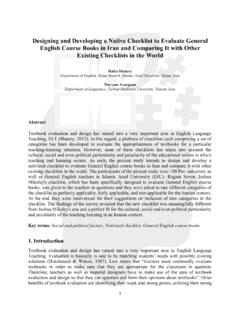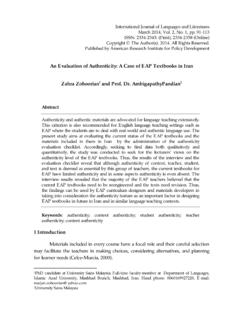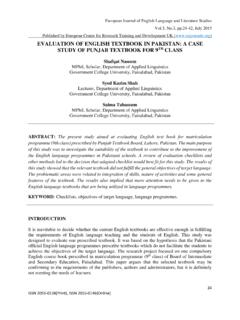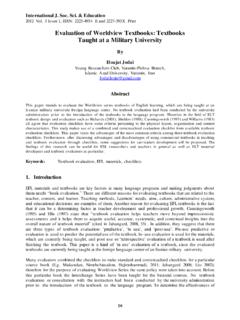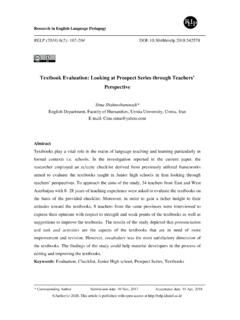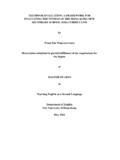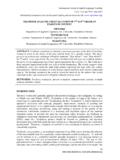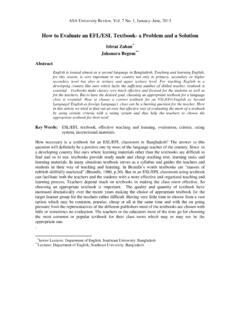Transcription of Developing criteria for textbook evaluation David Williams
1 Developing criteria fortextbook evaluationDavid WilliamsThis article shows how criteria can be developed for evaluating Englishlanguage textbooks. It presents a scheme for evaluation which can beused to draw up a checklist of items relevant to second (or foreign)language teaching. Instructions for using the checklist are given as away of suggesting how teachers can evolve their own criteria fordifferent situations where there is a shortage of trained teachers, languageteaching is very closely tied to the textbook . This does not mean, of course,that the method demonstrated in the textbook is always faithfully reflectedin the method as practised by the teacher. It is ironical that those teacherswho rely most heavily on the textbook are the ones least qualified tointerpret its intentions or evaluate its content and method.
2 The textbookcan be a tyrant to die teacher who, in his or her preoccupation withcovering die syllabus, feels constrained to teach every item in exactly thesame sequence and context in which it is presented by the textbook textbook should be used judiciously, since it cannot cater equally tothe requirements of every classroom setting. In bilingual and multilingualsituations, there are special limitations on the amount of English languageteaching that can be done via the textbook . The textbook can presentexamples of common difficulties, but diere are problems specific todifferent language groups which are left for the teacher to deal widi. It isalso likely that a textbook will outlast its relevance because of changes inthe language policy of the community for which it was question of relevance lies at the heart of this article.
3 My purpose is tosuggest a method by which teachers can develop criteria for evaluatingtextbooks used in teaching English as a second (or foreign) language. Thesuggested framework for evaluation takes into consideration firstly anumber of assumptions about second language teaching; and secondlylinguistic, pedagogical, and technical criteria related to diese dien suggest how evaluative statements can be generated from this frame-work, and how such statements can be weighted to suit a particularlanguage teaching environment or educational for The evaluative scheme (Fig. 1) relates assumptions about teaching a secondevaluation language to a set of linguistic, pedagogical, general, and technical are die four assumptions on which die scheme is The ESL (English as a second language) textbook should be consistent widimethodology die psychological and linguistic principles underlying current, acceptedmediods of second-language teaching.
4 But textbook writers should notjump aboard die bandwagon of innovation for die sake of Volume 37/3 July 1983251 Fig. 1. Scheme for evaluating ESL/EFL textbookiCriteria fur evaluationLinguistic/PedagogicalBaste assumptionsGeneral Speech Grammar Vocabulary ReadmgWritingTechnicalUp-to-date methodology of L2 teachingGuidance for non-native speakers of EnglishNeeds of learnersRelevance to socio-cultural environmentGuidance fornon-native teachersNeeds of second-language learnersRelevance to thesocio-culturalenvironmentThe textbook should provide appropriate guidance for the teacher ofEnglish who is not a native speaker of English. The untrained, or partiallytrained, teacher who does not possess native-like control over all aspects ofEnglish should not be left in any doubt concerning the procedures pro-posed by the textbook .
5 Otherwise, he or she may, for example, teach onlythe meanings of the minimal pair 'live/leave', completely ignoring thewriter's intention that these items should be used for to the needs of the second-language learner can be a complex taskin a multilingual setting. esl textbook writers have their work cut outwhen pupils in the same class speak many different mother tongues, andwhen English is not the second, but the third (or even the fourth) to be reckoned with is the distinction which in some cases has to bemade between English as a subject and English as a medium of are second-language problems in learning vocabulary and syntaxthat arise from differences between the cultures associated with the targetlanguage and the mother tongue.
6 In certain grey areas of usage, accept-ability may best be determined by reference to socio-cultural norms. ESLtextbook writers need to be sensitive to shifts in usage that are due to theworldwide spread of Figure 1, the criteria under the heading 'Linguistic/Pedagogical'involve techniques of textbook presentation as well as selection andorganization of skills, and aspects of the language to be taught. Whether atextbook is written for first or second-language speakers, it has to beassessed in terms of the following criteria :a. the completeness and appropriateness of the items presented;b. the activities suggested for practising the items selected;c. the sequencing of vocabulary, particularly the functional load, rate andmanner of entry and re-entry;d.
7 The relevance of its contexts and situations, and so on (cf. Tucker 1975).These criteria are derived from a combination of the linguistic and peda-gogical components of language teaching analysis (cf. Halliday et :207-22 and Mackey 1965). 'General' criteria embrace global con-siderations of methodology, the needs of the learner, die teacher, and diecommunity. 'Technical' criteria are concerned widi die quality of editingand publishing; die availability of supplementary materials; cost and dura-252 David Williamsbility of the text; authenticity of language and style of the writer, scheme can be adapted to suit particular contexts. For example, ourassumptions about the non-native teacher, the needs of the learner, and thesocio-cultural environment cannot be the same in Nigeria as in Malaysia,where English is a second language but not the language of , the approach to English language teaching in Malaysia cannot bethe same now as it used to be up until 1969, when Bahasa Malay becamethe language of instruction.
8 The different purposes for which English isused must be reflected in the selection, gradation, presentation, and testingof language of items The scheme for evaluation can be used to draw up a checklist of cell in Fig. 1 would generate principles relevant to a particularcriterion or assumption. For example, the cell relating 'reading' withAssumption 3 'Needs of L2 Learners' would produce a principle such as:'Reading passages should be relevant to the mother-tongue experiences ofthe pupils'. The following seven principles derive from the cells relatingAssumption 2 'Guidance for non-native teachers' with general, linguistic/pedagogical, and technical esl textbook , should:1 give introductory guidance on the presentation of language items andskills (GENERAL)2 suggest aids for the teaching of pronunciation.
9 Phonetic system(SPEECH)3 offer meaningful situations and a variety of techniques for teachingstructural units (GRAMMAR)4 distinguish the different purposes and skills involved in the teaching ofvocabulary (VOCABULARY)5 provide guidance on the initial presentation of passages for readingcomprehension (READING)6 demonstrate the various devices for controlling and guiding content andexpression in composition exercises (WRITING)7 contain appropriate pictures, diagrams, tables, etc. (TECHNICAL).The 'Sample checklist for evaluation ' (Appendix) is not meant to beexhaustive. Items on it, grouped for convenience under logical headings,were generated in the same way, and teachers can evolve their own sets ofcriteria for different educational levels or language teaching situations.
10 Thecolumn for weighting on the left of the checklist , and the columns forrating on the right, can be used for adapting evaluative items to suit theparticular demands of the teaching can be indicated by numbers or letters ( A: very useful; B:quite useful; C: fairly useful; D: not so useful). The weighting of individualitems or groups of items depends upon the level of the pupils (primary orsecondary) and the objectives of the curriculum. The evaluation of aprimary texdaook would emphasize technical criteria such as choice oftypeface, colourful illustrations, and die use of aids like workbooks. In acontext where English is a medium of instruction, an important criterionwould be diat texubooks should provide balanced and systematic trainingin all language textbook evaluation 253 The numbers given in the righthand columns indicate the extent towhich a given textbook , satisfies each criterion on the checklist (4: to thegreatest extent; 3: to a large extent; 2: to some extent; 1 :just barely; 0: not at all).

